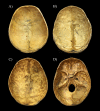Tracking down the White Plague. Chapter three: Revision of endocranial abnormally pronounced digital impressions as paleopathological diagnostic criteria for tuberculous meningitis
- PMID: 33740029
- PMCID: PMC7978373
- DOI: 10.1371/journal.pone.0249020
Tracking down the White Plague. Chapter three: Revision of endocranial abnormally pronounced digital impressions as paleopathological diagnostic criteria for tuberculous meningitis
Abstract
Abnormally pronounced digital impressions (APDIs) on the endocranial surface develop secondary to a prolonged rise in the intracranial pressure. This can result from a number of pathological conditions, including hydrocephalus due to tuberculous meningitis (TBM). APDIs have been described with relation to TBM not only in the modern medical literature but also in several paleopathological studies. However, APDIs are not pathognomonic for TBM and their diagnostic value for identifying TBM in past human populations has not been evaluated in identified pre-antibiotic era skeletons. To assess the diagnostic value of APDIs for the first time, a macroscopic investigation was performed on skeletons from the Terry Collection (Smithsonian Institution, Washington, DC, USA). Our material consisted of 234 skeletons with tuberculosis (TB) as the cause of death (TB group) and 193 skeletons with non-tuberculous (NTB) causes of death (NTB group). The macroscopic examination focused on the stage of the prominence and frequency of APDIs in the TB group and NTB group. To determine the significance of difference (if any) in the frequency of APDIs between the two groups, χ2 testing of our data was conducted. We found that APDIs were twice as common in the TB group than in the NTB group. The χ2 comparison of the frequencies of APDIs revealed a statistically significant difference between the two groups. In addition, APDIs with more pronounced stages were recorded more frequently in the TB group. Our results indicate that APDIs can be considered as diagnostic criteria for TBM in the paleopathological practice. With suitable circumspection, their utilization provides paleopathologists with a stronger basis for identifying TB and consequently, with a more sensitive means of assessing TB frequency in past human populations.
Conflict of interest statement
The authors have declared that no competing interests exist.
Figures




References
Publication types
MeSH terms
LinkOut - more resources
Full Text Sources
Other Literature Sources
Miscellaneous

